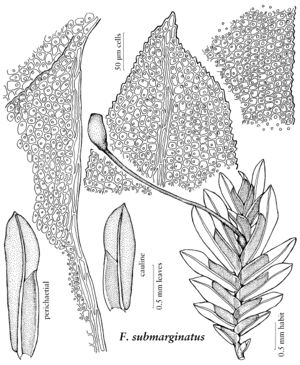Fissidens submarginatus
Flora 29: 133. 1846,.
Plants to 5 × 2 mm. Stem unbranched and branched; axillary hyaline nodules absent; central strand weak. Leaves as many as 10 pairs, lanceolate to lingulate, acute to obtuse-apiculate, to 1.3 × 0.4 mm; dorsal lamina narrowed abruptly proximally, ending at insertion, not decurrent; vaginant laminae ± 1/2 leaf length, equal; margin serrulate, limbate and entire on complete length of vaginant laminae and often on proximal portion of adjacent ventral laminae of all leaves except smallest, limbidial cells 1-stratose; costa percurrent to ending 2–3 cells before apex, bryoides-type; laminal cells 1-stratose, distinct, mammillose, firm-walled, quadrate to hexagonal, 7–9 µm. Sexual condition rhizautoicous; perigonia gemmiform, proximal to fertile and infertile stems. Sporophytes 1 per perichaetium. Seta to 3.5 mm. Capsule theca exserted, erect, radially symmetric, to 0.6 mm; peristome scariosus-type; operculum to 9.4 mm. Calyptra cucullate, smooth, to 0.5 mm. Spores 11–23 µm.
Habitat: Moist, disturbed soil and around bases of trees, mostly in cypress swamps
Distribution

La., Mexico, West Indies, Central America, South America, Africa.
Discussion
Fissidens submarginatus is most likely to be confused with F. leptophyllus. Both species have mammillose laminal cells, serrulate leaf margin, and limbidium of 1-stratose cells restricted essentially to vaginant laminae. The limbidium is the best character by which these two species are separated. In F. submarginatus the limbidium consistently extends the entire length of the vaginant laminae of most or all leaves, and on occasion extends a short distance onto the proximal part of the adjacent ventral lamina. In contrast, the limbidium in F. leptophyllus consistently extends no more than 1/2 the length of the vaginant laminae of most leaves. Minor differences can also be found in the shape of the leaf apex (usually apiculate vs. not apiculate), costa length (ending 2–3 cells before the leaf apex vs. ending 2–6 cells before the leaf apex), and cell size (7–9 µm versus 7–12 µm).
Selected References
None.
